 What is the Best Nutrition Plan to Follow?
What is the Best Nutrition Plan to Follow?
What is the best nutrition plan to follow? I get this question all the time from my patients, readers, and followers. I recommend using a personalized nutrition plan based on your personal health history, symptoms, health challenges, and goals. However, there are some major principles to follow and issues to look out for. So, I want to go over my general recommendations for designing the best nutrition plan to follow.
In this article, I will go over the basics of personalized nutrition. You will learn about the basics of a real food diet, including the importance of protein, fiber, fruits, greens, herbs, spices, and fermented foods and drinks. I will discuss food allergies and sensitivities and potential food timing issues.
You will gain insights into macronutrients within a nutrition plan, including potential problems with digesting protein, fats, and fiber and what to do about it. I will go over some main nutritional plan considerations to account for, including potential issues with FODMAPs, histamine, oxalates, nightshades, and mycotoxins. Finally, I will recommend additional nutrition plan considerations, including supplementation.
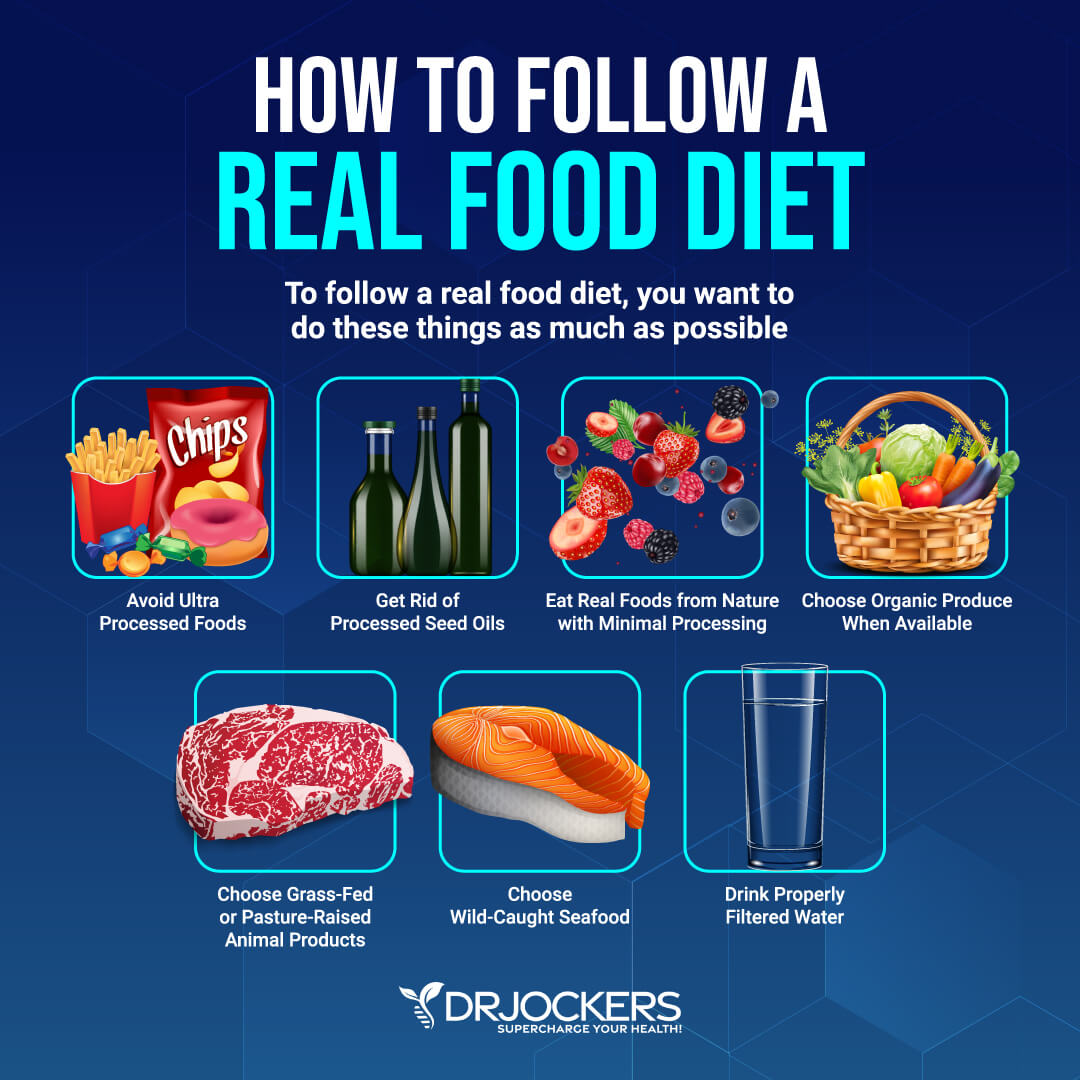
Personalizing Your Nutrition
I always recommend a personalized nutrition plan. We all have different bodies, different health issues, and different goals. Of course, there are some basic principles we should follow, such as consuming a real food diet with plenty of protein, healthy fats, greens, and veggies, as I will explain in this article. But depending on your situation, you may need different ratios, you may need to avoid specific foods, or you may need to eat more of certain other ones.
Your goal is to feel good after and in between your meals. If you have unwanted symptoms, you may be eating something you have a sensitivity to, you may have exceeded a threshold for a particular macronutrient, such as fat, carbs, or fiber, or may have triggered an intolerance, for example, by eating too much histamine, too much FODMAP, or too much gluten.
Follow the basic principles of a real food diet, as I will be explaining in the next section, and if you are not feeling your best after or in between your meals, it is time to play around and check into some issues. Don’t worry, I will go over potential issues, such as digestive issues, histamine intolerance, high FODMAPs, nightshade sensitivity, and other problems you may need to investigate if you are not doing your best.
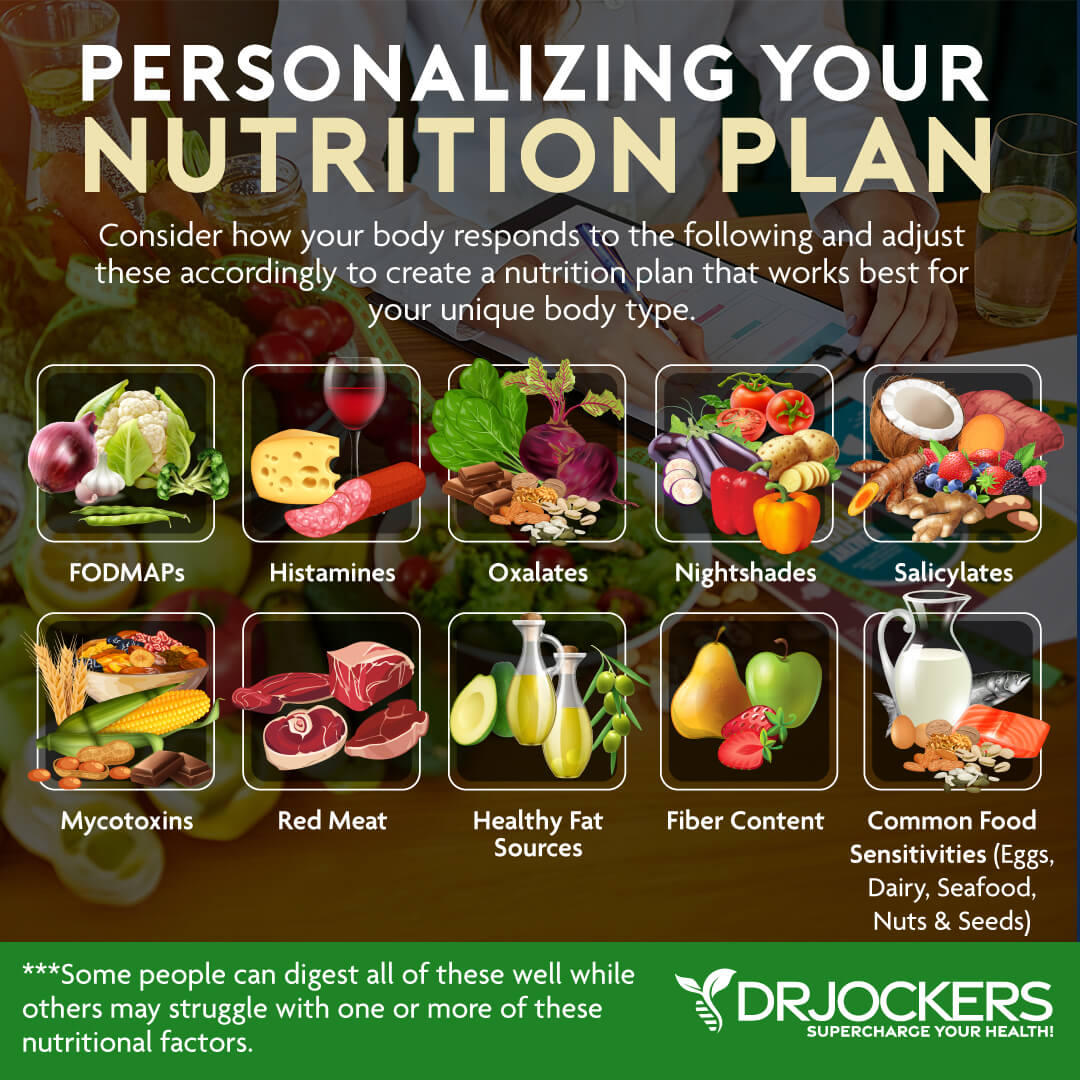
Real Food Diet
No matter what macronutrient ratios you are targeting and what micronutrient levels you want to improve, the main goal is to follow a real food diet instead of relying on packaged, overly processed foods (1, 2). This is the basis of every good nutrition plan.
What does this mean though? You want to avoid ultra-processed foods completely! This means packaged foods with a long list of ingredients, most of which you can’t pronounce, including artificial ingredients, additives, and chemicals.
Avoid unhealthy fats, such as refined oil and hydrogenated oils. Focus on healthy fats and lean meats. I will discuss the best sources of those in the next section. Choose organic as much as possible, and for animal products, ideally consume organic grass-fed beef and meat, pasture-raised poultry and eggs, and wild-caught fish and seafood, and wild game.
Reduce your grain consumption. Sourdough and low-gluten grains are your best choices in lower quantities. Many people need to avoid gluten completely. If that’s you, avoid sourdough and other gluten products. Quinoa, amaranth, buckwheat, wild rice, brown rice, and chickpea pasta may be great options for gluten-free grain-like foods.
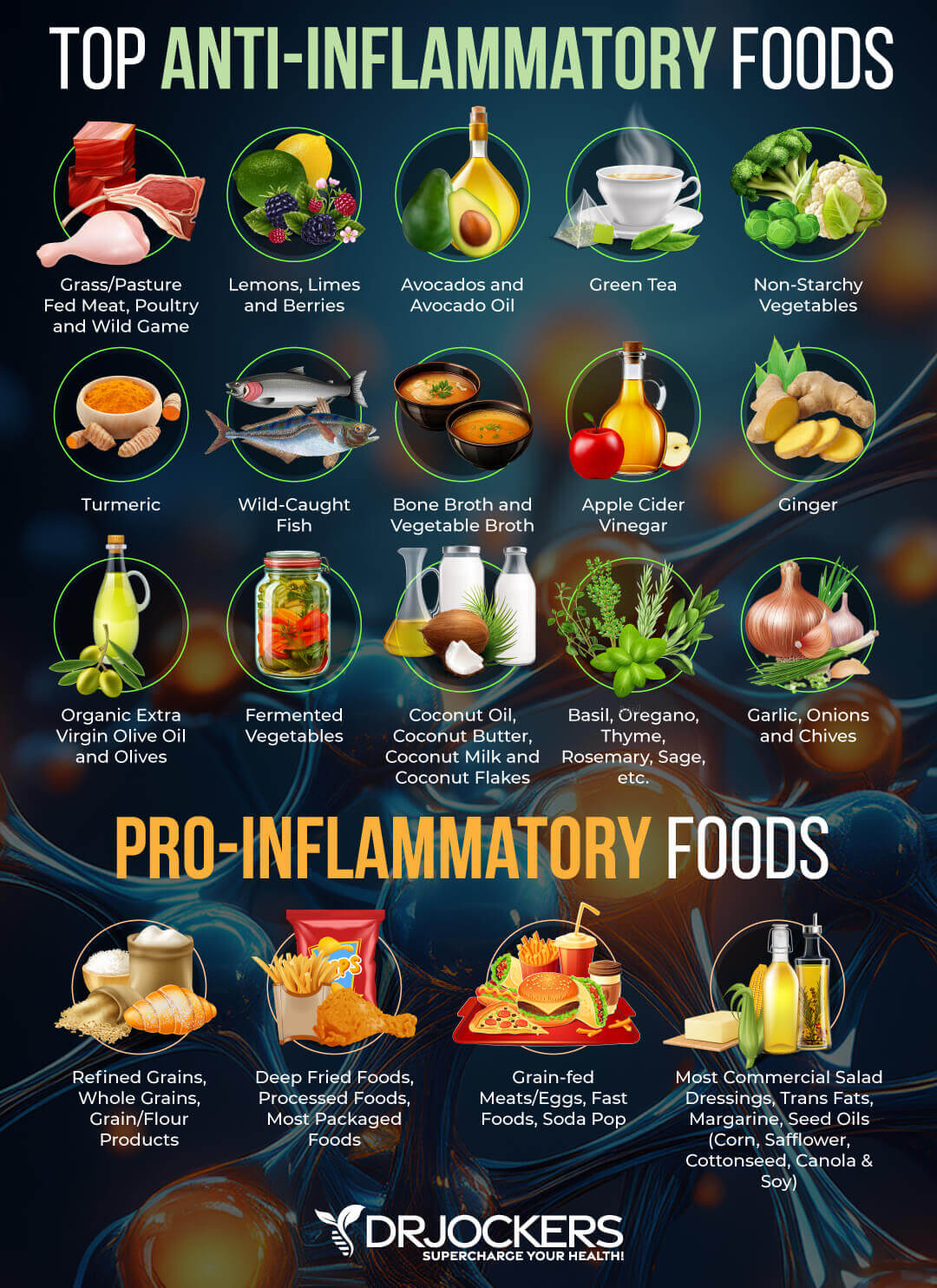
Prioritize Protein Levels
Eating enough protein is critical for building muscle, burning fat, balancing blood sugar levels, supporting energy, reducing inflammation, lowering pain, and more (3, 4, 5). Generally speaking, I recommend around 30 to 60 grams of protein each meal.
This may depend on the individual though. If you are looking to build muscle or engage in intense strength and muscle-building training, you may need more. However, most individuals do well on 30 to 60 grams of protein per meal.
Healthy sources of protein include grass-fed beef, pasture-raised poultry, pasture-raised eggs, wild-caught fish and seafood, and wild game. Nuts, seeds, and legumes can also add some extra protein to your diet.
Not everyone does well on legumes, so if it causes you digestive issues or food sensitivities, reduce or avoid it. Dairy is another protein source that’s not right for everyone. If you do well on dairy, you may use that as a protein source, too. However, I recommend choosing grass-fed raw milk, grass-fed pasteurized milk, goat milk, sheep milk, or camel milk instead, as you tolerate it, and staying away from conventional dairy.
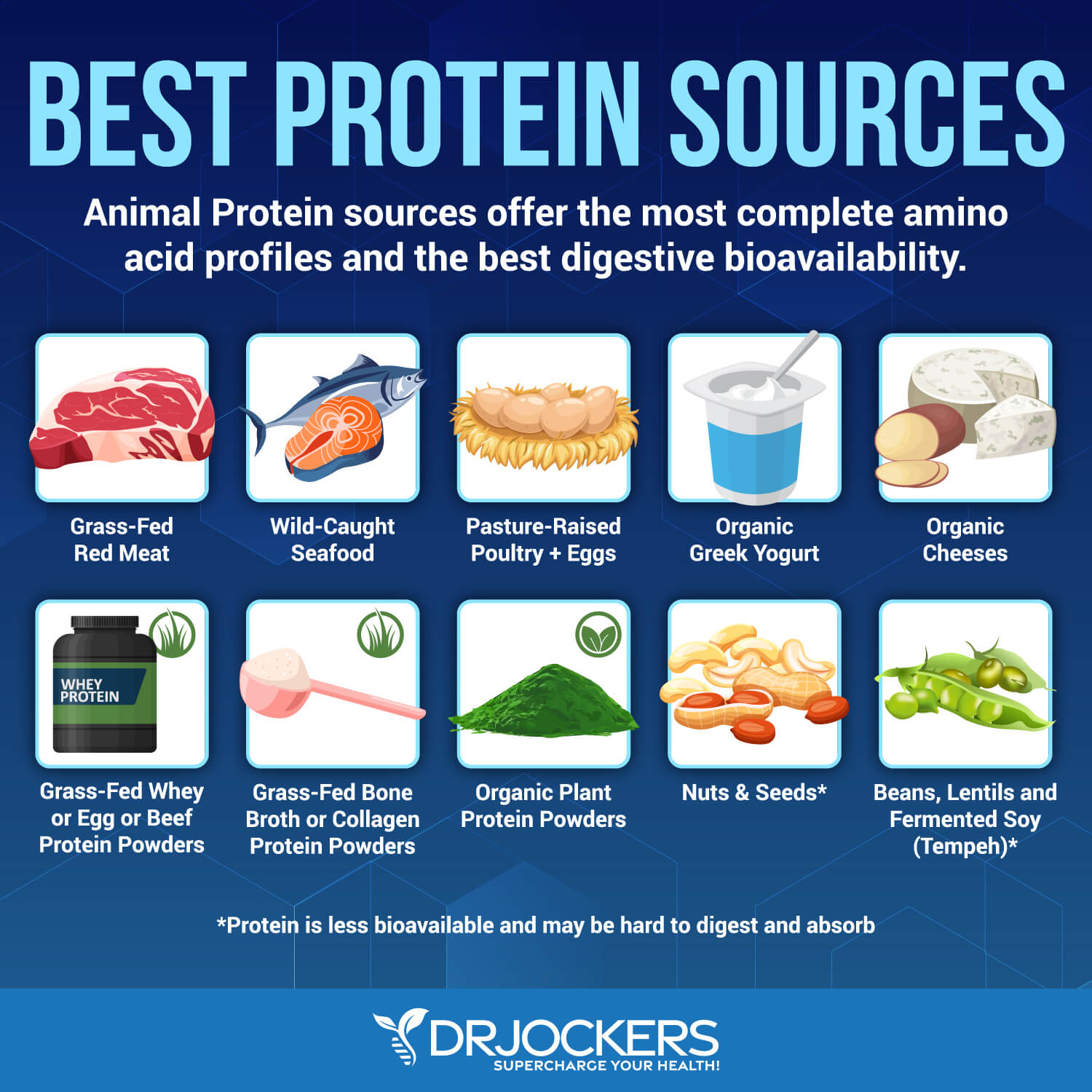
Personalize Your Fat Content
Consuming enough healthy fats is just as critical as eating enough protein. Healthy fats are essential for reducing inflammation and pain health, supporting brain function, heart health, skin health, and hormonal health, stabilizing blood sugar levels, and supporting a healthy weight (6, 7, 8).
The amount of fat you need in your diet depends on your personal situation, health history, symptoms, and goals. While some people do very well on 60 grams of fat per meal, for others, even 20 grams is too much. If you have gallbladder issues or poor bile flow, too much fat can turn into a problem.
The kind of fat you eat matters a lot. Avoid unhealthy fats, such as refined oils, fatty fried foods, and other sources of trans fats. Choose healthy fats, including olives, extra-virgin olive oil, avocados, avocado oil, coconut oil, coconut milk, MCT oil, grass-fed butter, ghee, and pasture-raised eggs. Fatty fish are also great sources of healthy fats that support your well-being.

Add Colorful Fruits, Veggies, Herbs & Spices
As a general rule, I recommend eating lots of colorful fruits, vegetables, herbs, and spices. Some personalized nutrition plans will incorporate more plant-based foods than other nutrition plans based on how each individual digests them and the overall experience they have with them.
Eat the rainbow, as they say. Each color is associated with different nutrients and different benefits. And each leafy green, vegetable, herb, spice, and fruit have a different benefit.
All of these are full of powerful minerals, vitamins, antioxidants, and fiber to support your digestion, lower inflammation, fight oxidative stress, decrease pain, support weight loss, increase energy, and enhance overall health (9, 10).
Some of my favorite greens include kale, Swiss chard, collard greens, romaine lettuce, Bok choi, and cabbage. Some nutrient-rich veggies include cucumbers, celery, bell peppers, broccoli, cauliflowers, carrots, beets, snow peas, sugar snap peas, onions, garlic, leek, eggplant, zucchini, Brussels sprouts, and sweet potatoes.
Some people have issues with eating cruciferous vegetables. If you do, avoid those. Additionally, mushrooms are not vegetables, they are fungus, and they also offer fantastic health benefits.
Some of my favorite herbs and spices include turmeric, ginger, mint, oregano, rosemary, thyme, dill, and basil. Some low-glycemic index fruits include strawberries, blueberries, raspberries, blackberries, cranberries, green apples, citrus fruits, cherries, peaches, and plums.
Some fruits that are moderate in GI index include mangos, pineapples, oranges, figs, kiwis, and bananas. If you are following a lower-carb diet or have blood sugar issues, lower GI fruits are a better option. However, in moderation, moderate and higher GI fruits offer beneficial micronutrients as well.
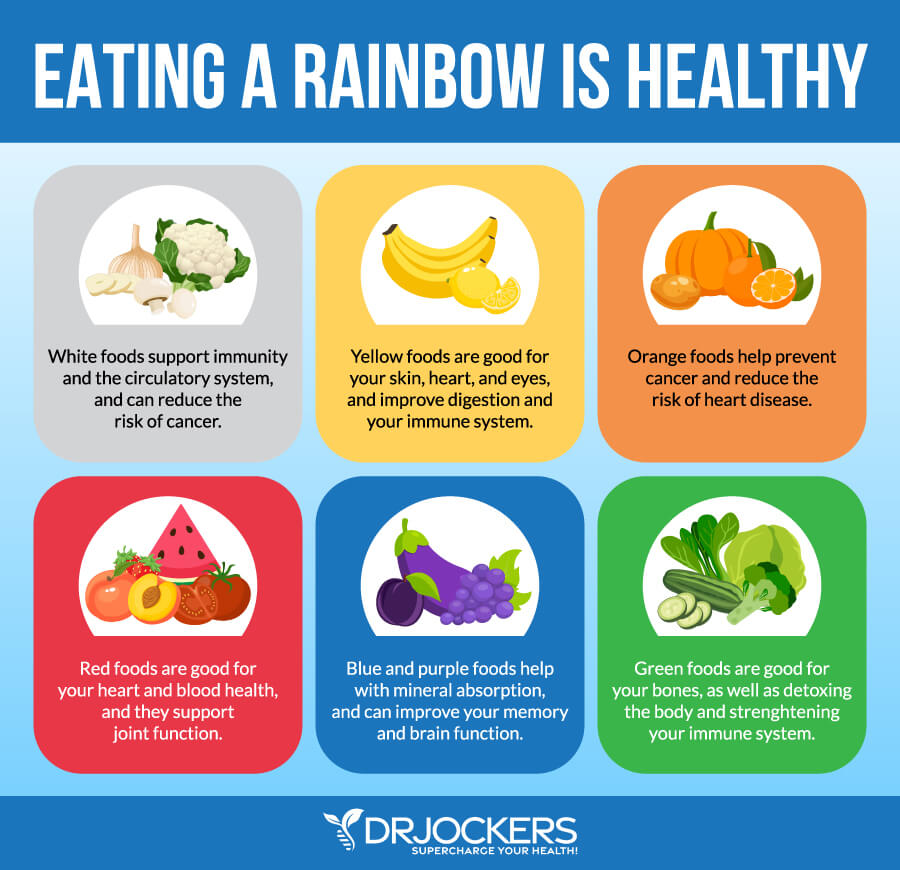
Consider Adding Fermented Foods & Drinks
Finally, for gut health, I also recommend that you consider adding fermented foods and drinks to your diet. They are high in probiotics and post-biotics and can help to support your gut microbiome and reduce inflammation (11).
Some of the best probiotic-rich fermented foods and drinks include sauerkraut, kimchi, fermented vegetables, fermented herbs, kefir, coconut yogurt, and kombucha.
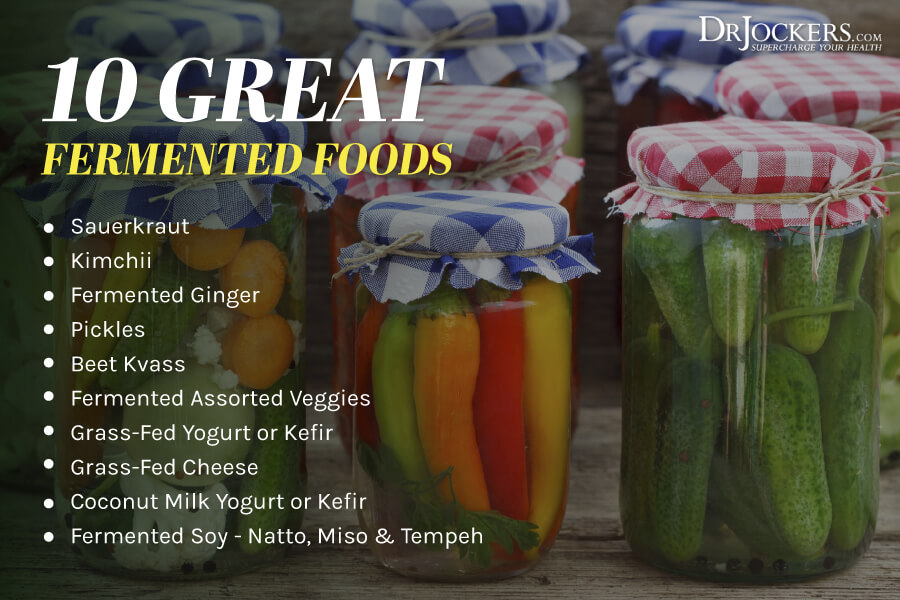
Observe for Food Allergies & Sensitivities
Food allergies and food sensitivities are very common issues. Food allergies are immunologic hypersensitivity (IgE reaction), food sensitivities are delayed immunologic reactions (IgG and IgA reactions), and food intolerances are non-immunologic reactions to food. What does this mean?
Food allergies cause an immediate reaction that you experience right after you are eating a certain food. These reactions or symptoms may include swelling, rashes, redness, itching, hives, difficulty breathing, throat causing, and in severe cases, an anaphylactic shock.
Food sensitivities are less dangerous. However, they are much sneakier and are often missed. Food sensitivities are delayed reactions to food that may occur hours or even days after you consume the food. Since you don’t know about the issue, you may consume these foods regularly, leading to chronic issues.
Symptoms of food sensitivities may include gas, bloating, abdominal pain, cramping, diarrhea, nausea, constipation, headaches, migraines, eczema, other skin issues, brain fog, fatigue, congestion, runny nose, other sinus issues, depression, poor immunity, and more.
Food intolerances often produce similar issues and delayed, chronic reactions as food sensitivities, but they are different. They occur because of a deficiency of an enzyme necessary to digest a certain food. For example, lactose intolerance develops due to a lack of the enzyme lactase, which is needed to break down lactose, a sugar found in cow’s milk.

You may develop histamine intolerance if your body doesn’t have enough DAO or HNMT enzymes to break down excess histamine, causing histamine build-up and histamine reactions. I will discuss food intolerances later in this article.
While noticing and avoiding food allergies is easier because of the immediate and often severe symptoms, food sensitivities and food intolerances are trickier. Common food sensitivities include gluten, corn, dairy, eggs, shellfish, nuts, and seeds. Many must avoid or reduce these or some of these foods. However, you may have issues with other, less common foods.
There are food sensitivity blood tests to help you spot these issues (12). However, using an elimination diet and watching your symptoms may be the best way to note your personal food sensitivities. You can learn more about elimination diets from this article. Food sensitivities can change over time, so I recommend redoing the elimination diet yearly or if new symptoms occur.
As for food intolerances, I will get into histamine intolerance and oxalate issues later in this article and you can find many blogs on the topic on my website. Avoiding foods that you have issues with is critical to avoid inflammation, pain, and symptoms and enhance your health.

Watch Food Timing Issues
The timing of your meals can also be important (13). Avoid eating too late. Ideally, allow 3 to 5 hours between dinner and bedtime. It is particularly important that you avoid nighttime snacking, especially sugar, heavy foods, and alcohol.
Eating too late at night can lead to blood sugar imbalances, hypoglycemic symptoms, acid reflux, other digestive issues, poor sleep, and low energy during the day. Drinking herbal teas, such as chamomile, valerian, passionflower, or lavender, may be a good option instead of snacking at night to help you sleep and support your health.
Leaving enough time between your meals can also be helpful. A lot of people benefit from intermittent fasting or time-restricted feeding. I will talk more about this in a later section.
But leaving 12 to 16 hours, including your overnight sleep, during every 24 hours reserved for fasting (not eating) can be beneficial for your health. During the remaining eating window, spread 2 to 3 meals evenly with 3 to 4 hours or more between meals to meet your caloric and nutrient needs may be a great way to support your digestion and blood sugar balance.
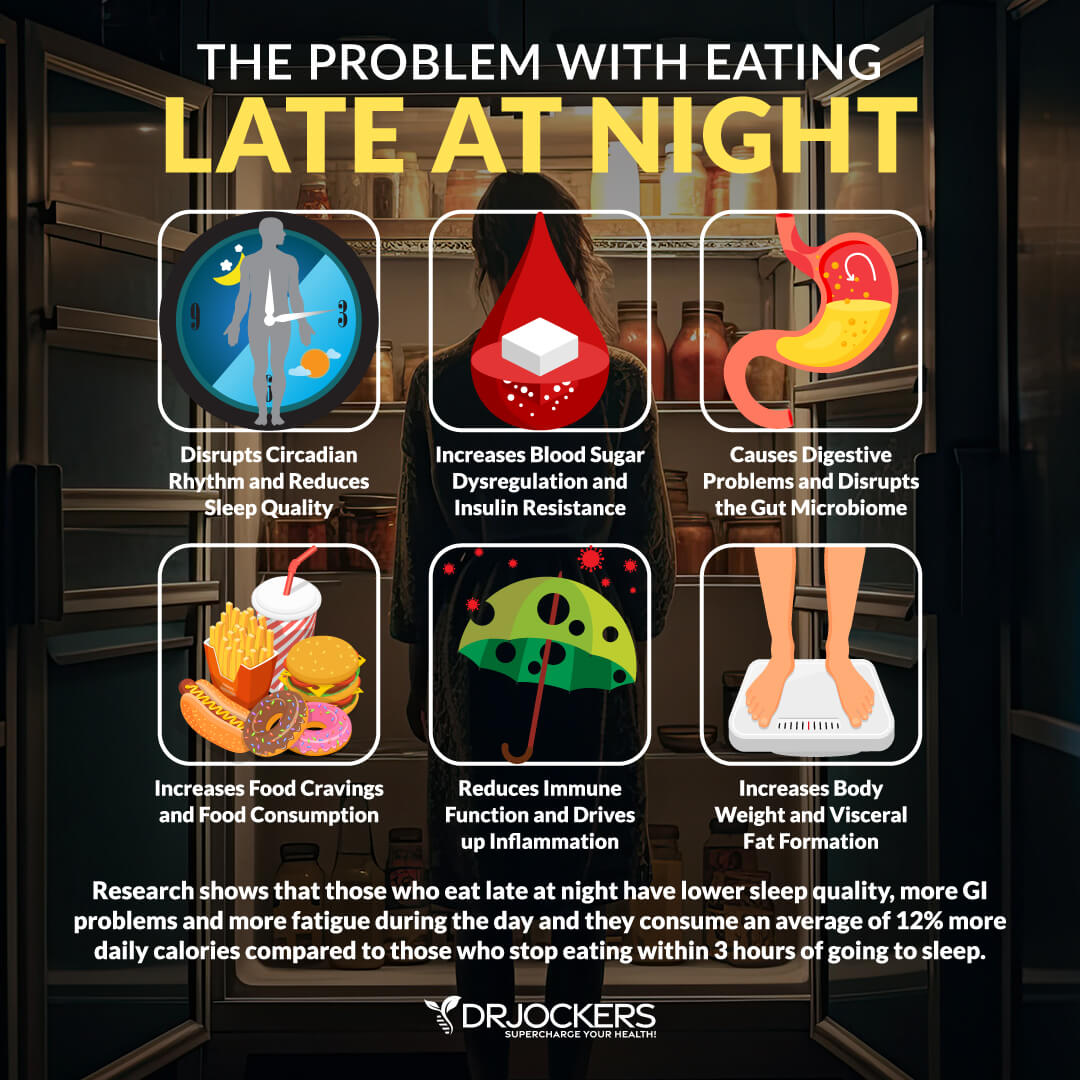
Insights into Macronutrients in Nutrition Plan
The right macronutrient balance is essential for every nutrition plan. However, the macronutrient ratio you follow may depend on your body, overall health and health issues, symptoms, and goals. While some may do well or need a very high protein or high-fat diet, others need to lower their protein or fat intake.
While fiber is important for our body, not all of us tolerate it the same. Some nutrition plans will have high fiber levels while others need lower fiber levels. Here are the key things to pay attention to when establishing your nutrition plan:

Problems Digesting Protein
Protein is important for your health, but some people have problems digesting protein well. If protein foods are causing your digestive problems, it is probably because of low stomach acid levels. You can try to do the steak test and baking soda test to help confirm this issue.
I go over both of these tests in this article. I also recommend 10 strategies to improve your stomach acid levels and help your body digest protein better in this article. Lowering your protein level to the lower end of the recommended amount may also be beneficial for a while.
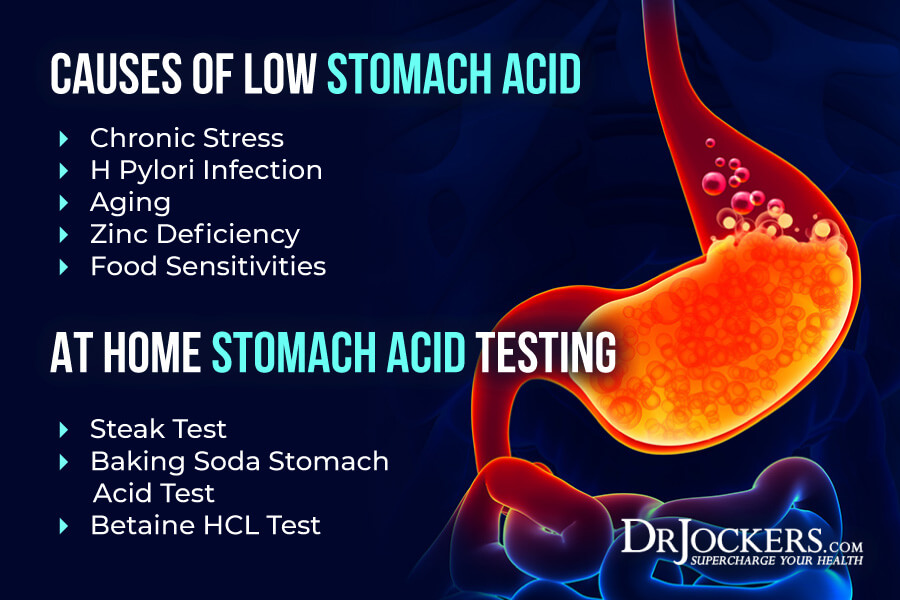
Problems Digesting Fats
Other people may have problems digesting fats. This is often the result of poor bile flow. I recommend performing a fat bomb test to confirm, as outlined in this article.
To improve your bile flow and support your gallbladder and liver, I recommend using herbs and strategies listed in this article, such as apple cider vinegar, lemon, lime, artichokes, parsley, cucumber, celery, mint, radishes, cilantro, milk thistle, ginger, turmeric, dandelion greens, sauerkraut, and green tea.

Problems Digesting Fiber
While fiber is beneficial for your digestion, some people have issues digesting fiber and experience digestive issues when eating too much. This may be the result of possible bacterial overgrowth and low enzyme production and often involves FODMAP issues.
In addition, everyone has a different fiber threshold. Some do great on very high-fiber diets, and some do better on lower fiber, while most do well in the middle somewhere. Pay attention to your personal needs.
You may benefit from improving your gut microbiome, reducing your fiber intake, and taking digestive enzymes. If you have issues with FODMAPs, a low FODMAP diet may be right for you, as outlined in this article. I also recommend checking out these 10 ways to improve your gut microbiome in this article.
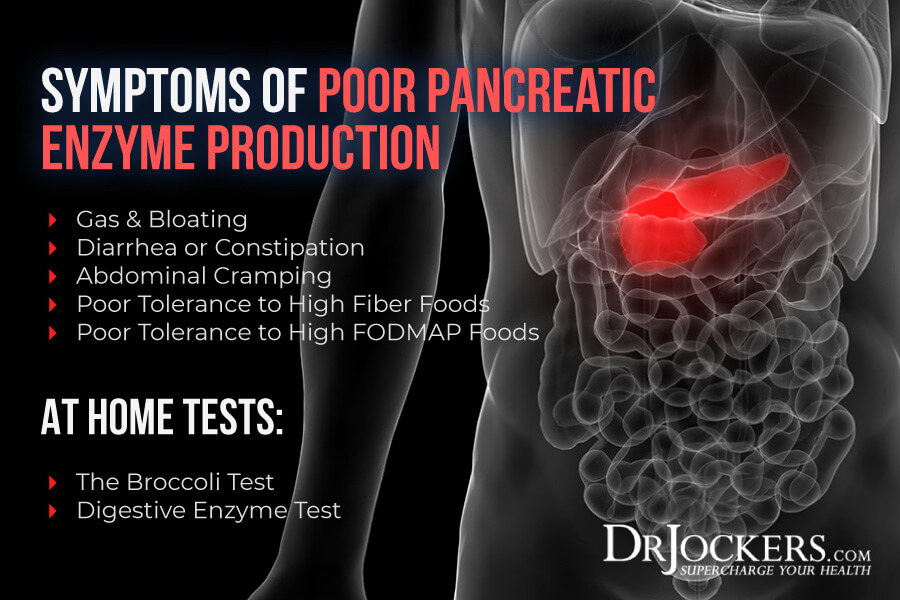
Nutritional Plan Considerations to Account For
There are also some nutrition plan considerations you may need to pay attention to. In this section I will share some potential nutrition issues some people struggle with. This does not mean you have to follow all these recommendations.
You may not have issues with any of these, in which case, you don’t have to remove any of the foods and nutrients listed in this section. You may only struggle with some of these issues, and you only have to focus on those.
Most only need to focus on one or two of the following issues and only for a short period of time. If you are uncertain about what may be causing your issues, you can try ruling out these issues one by one. Some may simply benefit from reducing the overall quantity of particular foods, such as reducing their fiber intake, or lowering but not eliminating FODMAPS, or reducing histamine only for one day a week.
Use the following list as guidance to figure out what your body needs. With that said, let’s look at some potential nutrition plan considerations.

FODMAPs
FODMAP is an acronym for naturally occurring Fermentable Oligo, Di- and Monosaccharides and Polyols. These include the short-chain carbs such as glucose, fructose (present with excess glucose), galactans, polyols, and lactose found widely in foods.
Symptoms related to FODMAPs may include abdominal pain, gas, bloating, cramping, nausea, constipation, or diarrhea. If you have digestive issues, you may benefit from following a low-FODMAP diet for the short term (14). If you need to follow a low FODMAP diet, I recommend following my tips in this article.
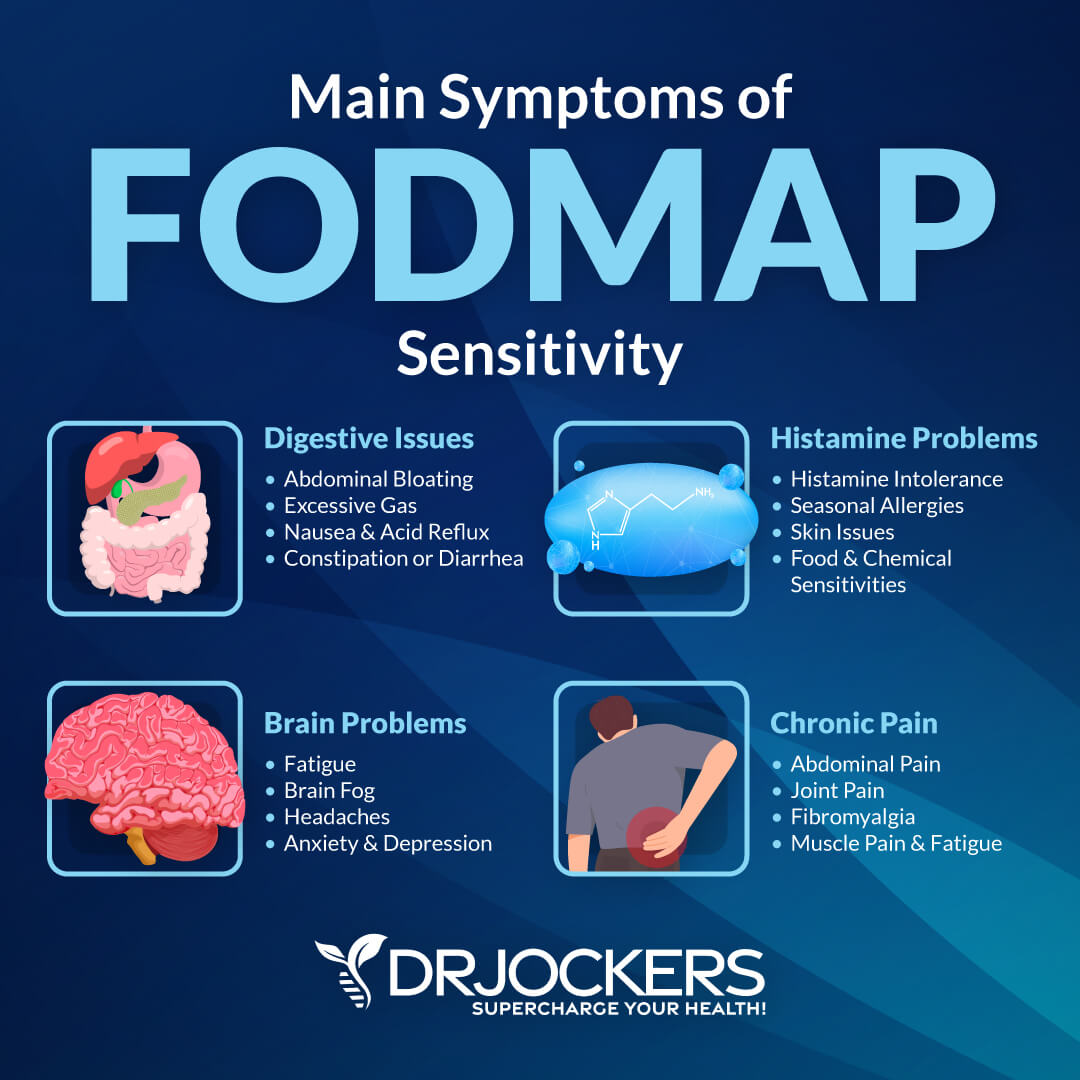
Histamine Content in Food
Histamine is an important neurotransmitter and immune messenger molecule. It is involved in processes involving hydrochloric acid secretion for digestion, triaging water reserves to key areas of the body, and the inflammatory response. Histamine intolerance means that your body cannot break down all the histamine, it leads to a histamine buildup and related symptoms (15).
Symptoms of histamine intolerance include digestive issues, migraines, headaches, brain fog, skin issues, hives, fatigue, arrhythmia, blood pressure issues, anxiety, sleep issues, and many other chronic issues.
Following a lower histamine diet, at least for a few months, can help to improve histamine intolerance. To learn more, I recommend checking out this article about histamine intolerance.
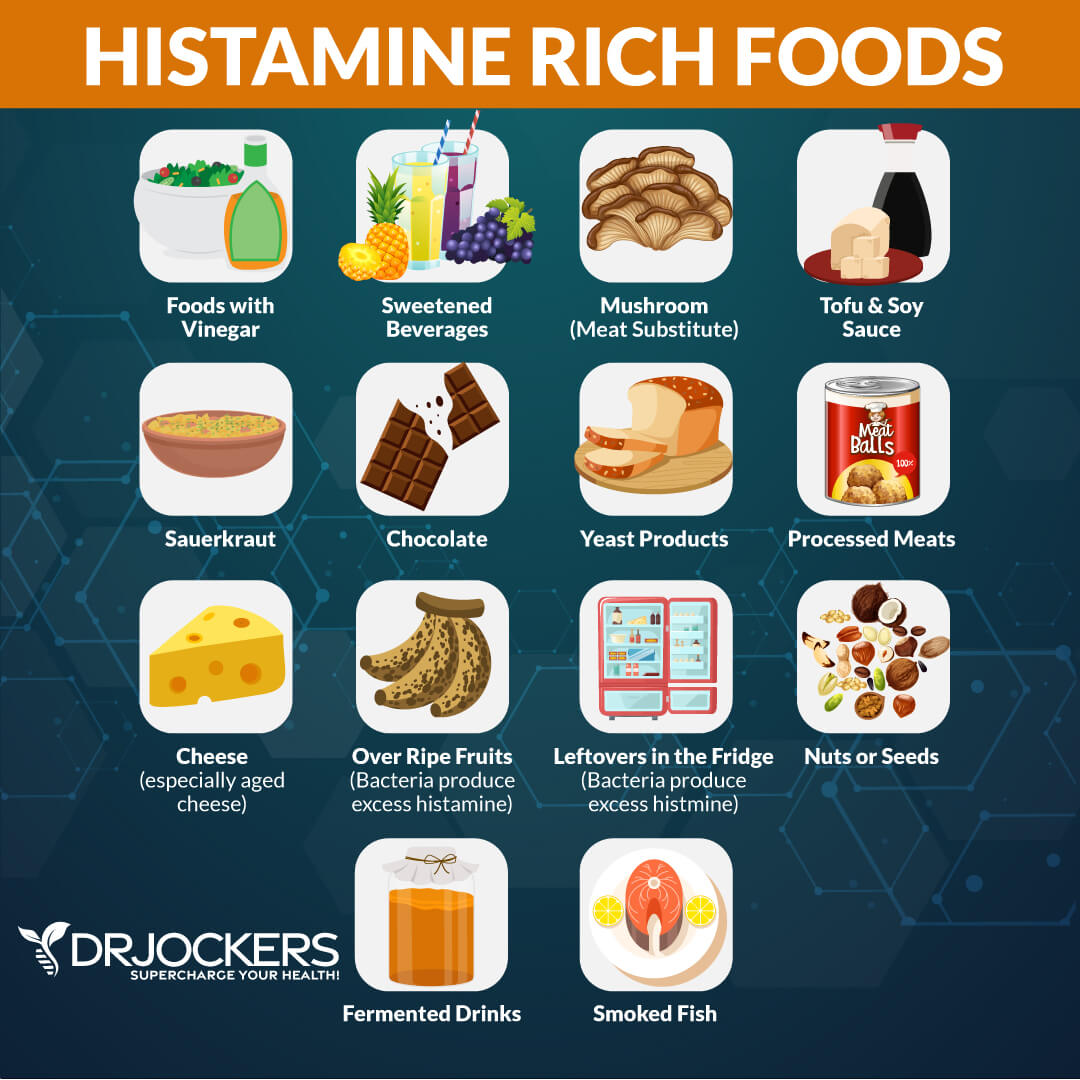
Oxalate Levels
Oxalates are naturally occurring compounds. They are found in plants, animals, and humans. High-oxalate foods include raspberries, Swiss chard, cocoa, buckwheat, tofu, miso, spinach, potatoes, yams, beans, rhubarb, beets., nuts, seeds, and others.
Symptoms of oxalate intolerance include joint pain and inflammation, urinary tract infections, kidney issues, abdominal issues, histamine reactions, sleep issues, and micronutrient deficiencies (16). To improve oxalate intolerance, you may benefit from a low-oxalate diet) I recommend following this article to learn more about a low-oxalate diet.
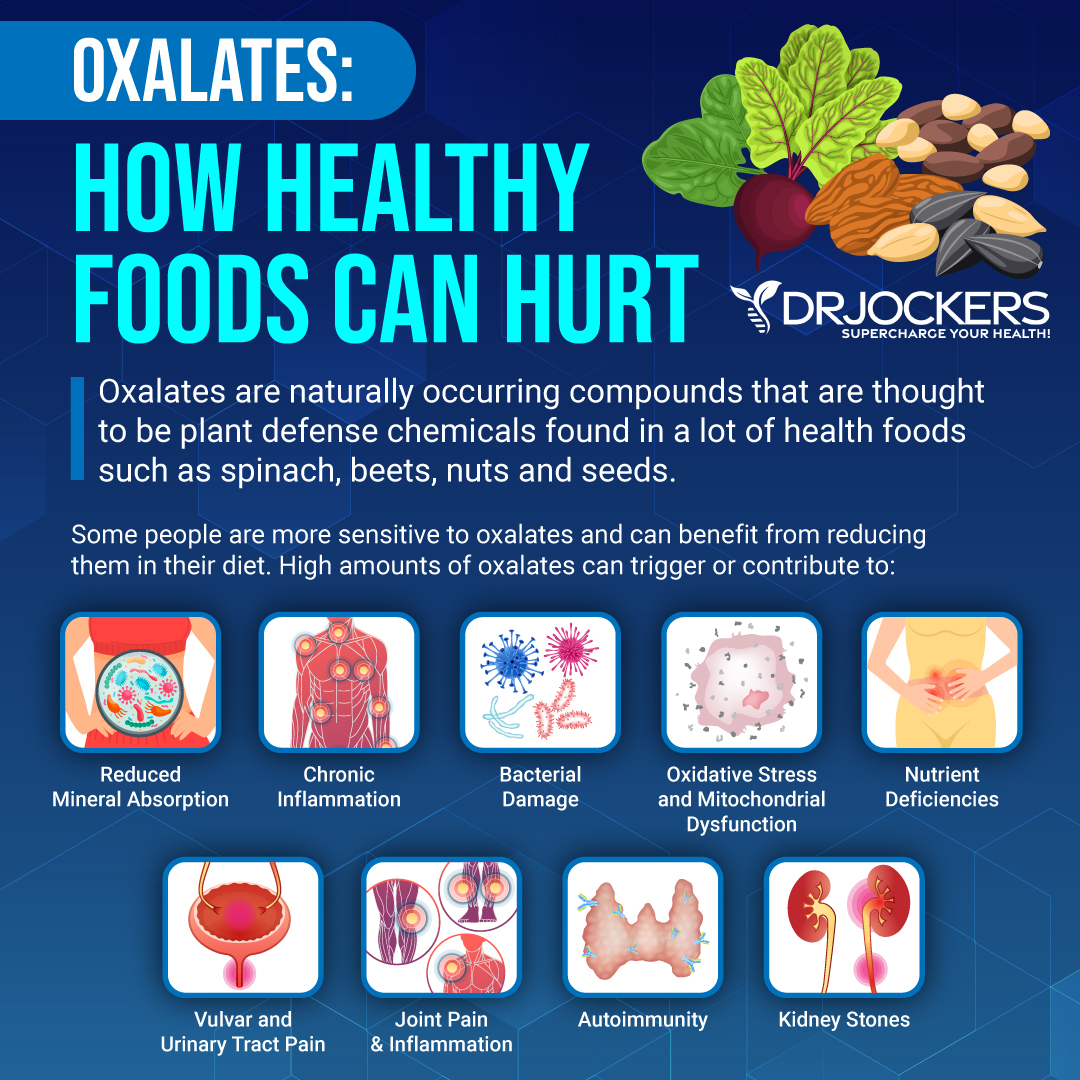
Nightshade Sensitivity
Some people also experience issues with nightshades (17). Foods high in nightshades include tomato, potato, and all pepper varieties except peppercorns, eggplant, okra, goji berries, tomatillos, sorrel, gooseberries, ground cherries, tobacco, paprika, cayenne pepper, and pepino melons.
Symptoms related to nightshade sensitivity may include headaches, migraines, water retention, congestion, skin issues, candida, digestive issues, fatigue, sleep issues, autoimmunity, muscle pain, joint pain, dark circles under the eyes, anxiety, and depression.
If you have issues with nightshade sensitivity, you may benefit from reducing or eliminating nightshades from your diet. I recommend reading this article about nightshades and nightshade sensitivity.
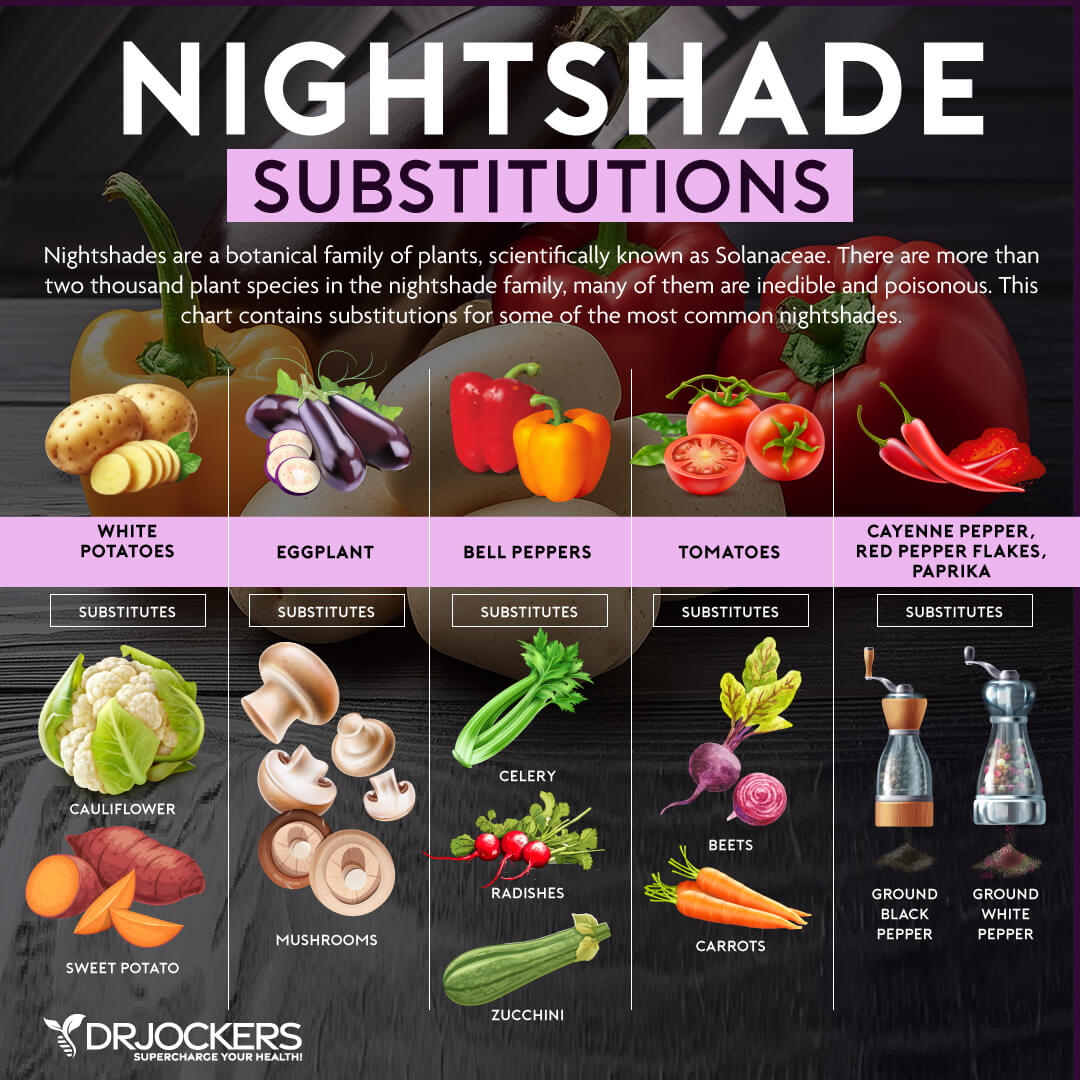
Salicylate Levels
You may also experience issues related to salicylate sensitivity (18). Salicylates are a general term for chemicals with salicylic acid as their base. They are a type of phenol occurring naturally in many plants and plant foods. Salicylates are produced by plants as part of their natural defense system against diseases, insects, fungi, harmful bacteria, and environmental stress.
Salicylic acid is used as an ingredient in synthetic salicylates, including aspirin (acetylsalicylic acid) and other medications, artificial colors, flavors, and preservatives, and many personal care products such as perfumes, lotions, toothpaste, mouthwash, and shaving creams contain salicylates.
Symptoms related to salicylates may include hyperactivity, memory loss, poor concentration, red cheeks and ears, respiratory issues, asthma, headaches, swelling of hands and feet, skin rashes, hives, or itchy skin, eczema, diarrhea, stomach pain, night or day wetting, irritability, defiant behavior, aggression, crying easily, emotionally sensitivity, and sleeping issues.
If you are experiencing these issues, you may benefit from a low-salicylate diet. You can learn more about salicylate sensitivity from this article.
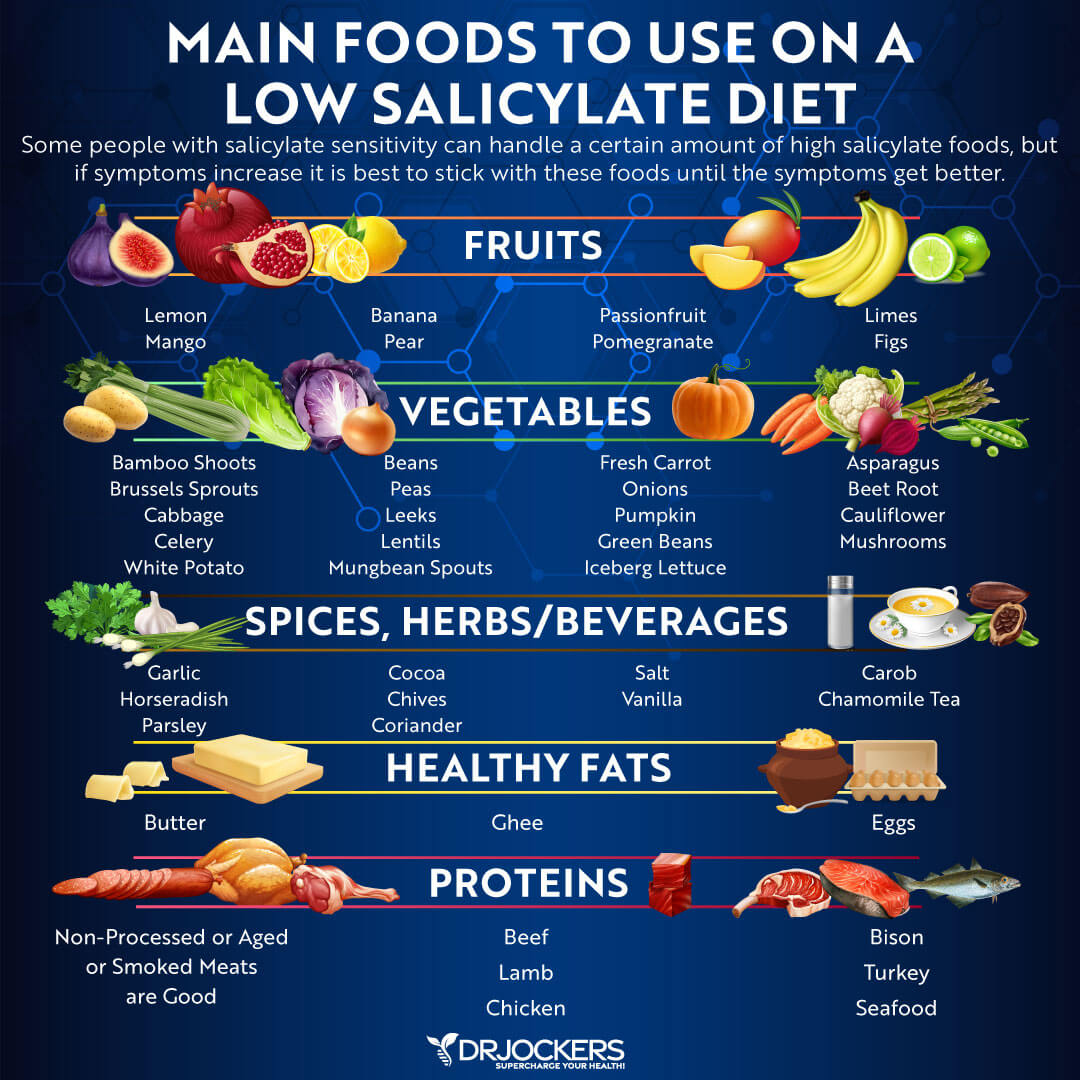
Mycotoxin Levels
Mycotoxins come from fungi, like mold. They are some of the most prevalent toxins in our environment that may lead to serious health problems. Foods that may include mycotoxins include alcoholic beverages, wheat, barley, rye, sugar cane, sugar beets, corn, sorghum, peanuts, cottonseed, hard cheeses, and soybean products (19).
Symptoms related to mycotoxins may include respiratory issues, skin issues, allergy-like problems, dry skin, hair loss, blurred vision, leaky gut syndrome, digestive issues, headaches, migraines, fatigue, sleep issues, chronic pain, unexplained weight gain or weight loss, insulin resistance, hormonal issues, chemical sensitivity, fibromyalgia, emotional changes, or behavioral changes. You can learn more about mycotoxins in this article.
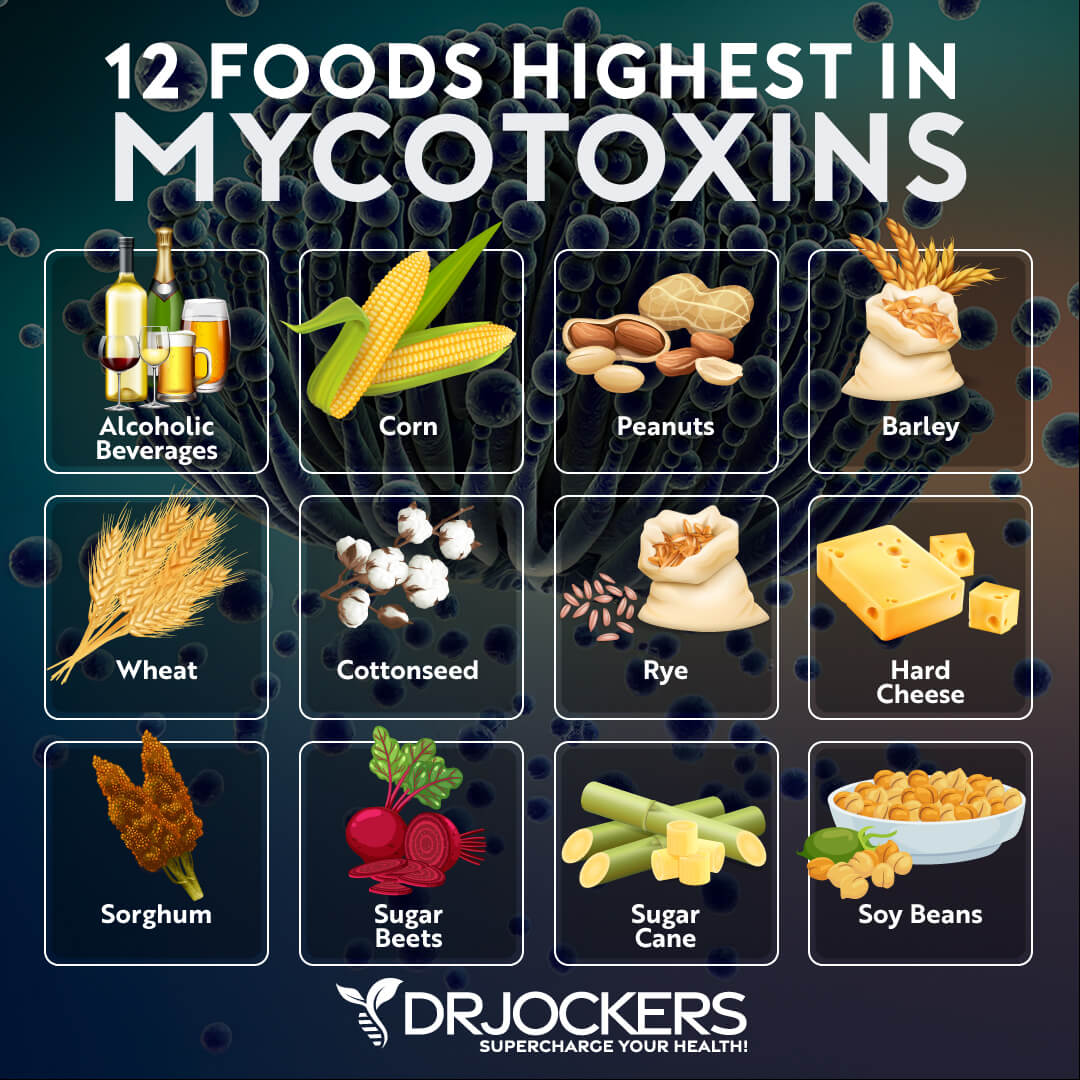
Additional Nutrition Plan Considerations
I also recommend some additional nutritional plan practices you may consider to support your health and well-being. The goal of a good nutrition plan is always to maximize nutrients and minimize toxin consumption.
Eating Organic as Much as Possible
I recommend eating organic as much as possible to avoid pesticides, herbicides, fungicides, added hormones, and other chemicals or toxins. Choose organic greens, vegetables, and fruits whenever you can. Ideally, you want to buy organic at all times.
If this is not available or affordable for all items, pay attention to the Dirty Dozen & Clean 15. Always shop organic from the foods on the Dirty Dozen list. Clean 15 foods may be okay non-organic but always wash and peel them well. For animal products, choose organic, grass-fed meat and butter, pasture-raised eggs and poultry, wild-caught fish and seafood, and wild game.
Shop locally as much as possible. Local farmer’s markets or joining a community-supported agriculture (CSA) farm are great options. You may also try growing your own food using organic gardening principles. A little veggie garden or herbs on your kitchen counter can go a long way.
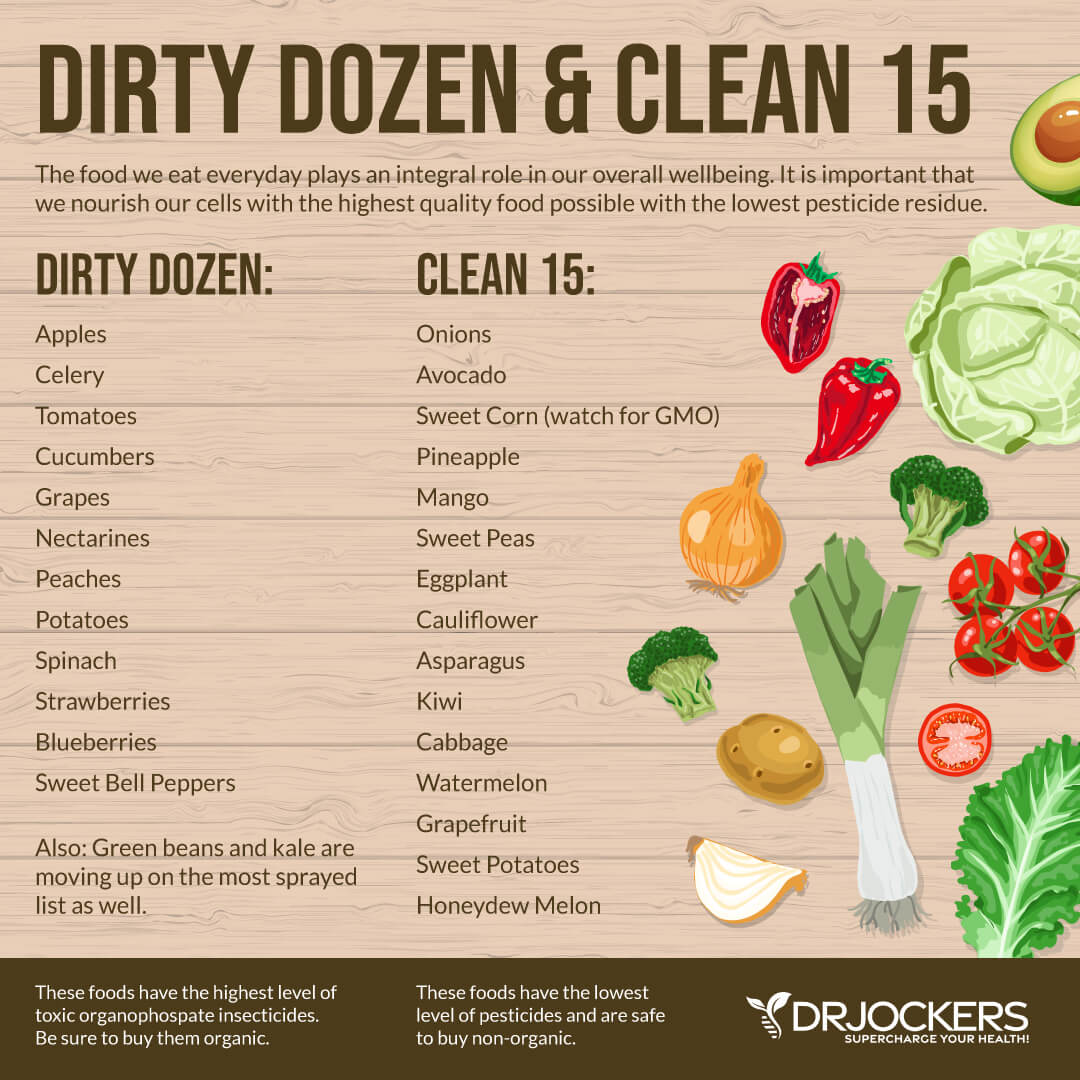
Good Water Filtration & Hydration Practices
Good water hydration is so important for your health. It supports overall digestion, skin health, joint health, energy levels, immune health, detoxification, brain health, energy levels, and more. I recommend that you drink plenty of clean, purified, filtered water.
I recommend investing in a high-quality water filtration system. Not all water filtration systems are made the same. There are three different home water filtration systems that can filter out fluoride along with other chemicals and toxins properly, including reverse osmosis, activated alumina, and steam distillation systems.
I recommend systems like Aquatrue or the Berkey system for low-cost filtration. The best water is the UltraLux Triple Action Hydrogen Water Machine which is what I use at home as it is powered by molecular hydrogen which reduces oxidative stress in the body and improves immune function.
For proper hydration, I recommend starting your day with 16 to 32 oz of water. You can even add some lemon juice or apple cider vinegar to kick-start your digestion. Drink about one glass every hour, at least 10 glasses a day.
If you are exercising a lot, sweating in the sun, using an infrared sauna, sweating a lot, or feeling dehydrated, drink more. If you are bored of the taste of plain old water, you may add lemon juice, berries, mint, basil, or other herbs for taste. Herbal tea, green juices, green smoothies, and hydrating vegetables and fruits are also great options to add more hydration.

Time-Restricted Feeding
Time-restricted feeding or intermittent fasting is a way of eating when you are cycling between periods of fasting or feasting. Time-restricted feeding may help to lower inflammation, improve insulin resistance, support cellular autophagy, and reduce your risk of chronic symptoms and health issues.
I recommend that you compress your eating window to 8 to 10 hours a day. Start with a 12-hour eating and 12-hour fasting window. Stop eating after dinner, for example, at 6 pm, and you will be ready for breakfast 12 hours later at 6 am. Gradually push your fasting window, moving your breakfast an hour, then two, then another hour later. Most people feel the best with 16 hours of fasting a day.
Remember that this is not about cutting calories or nutrients. You need to meet your caloric, macronutrient, and micronutrient needs during each eating period. I recommend eating 2 to 3 meals during these periods. Each meal should be high in protein following the principles I shared in this article.
I recommend that you avoid or minimize snacking during this time. If you must snack, keep it to a minimum and choose nutrient-dense whole foods. To learn more about intermittent fasting, I recommend reading this article.
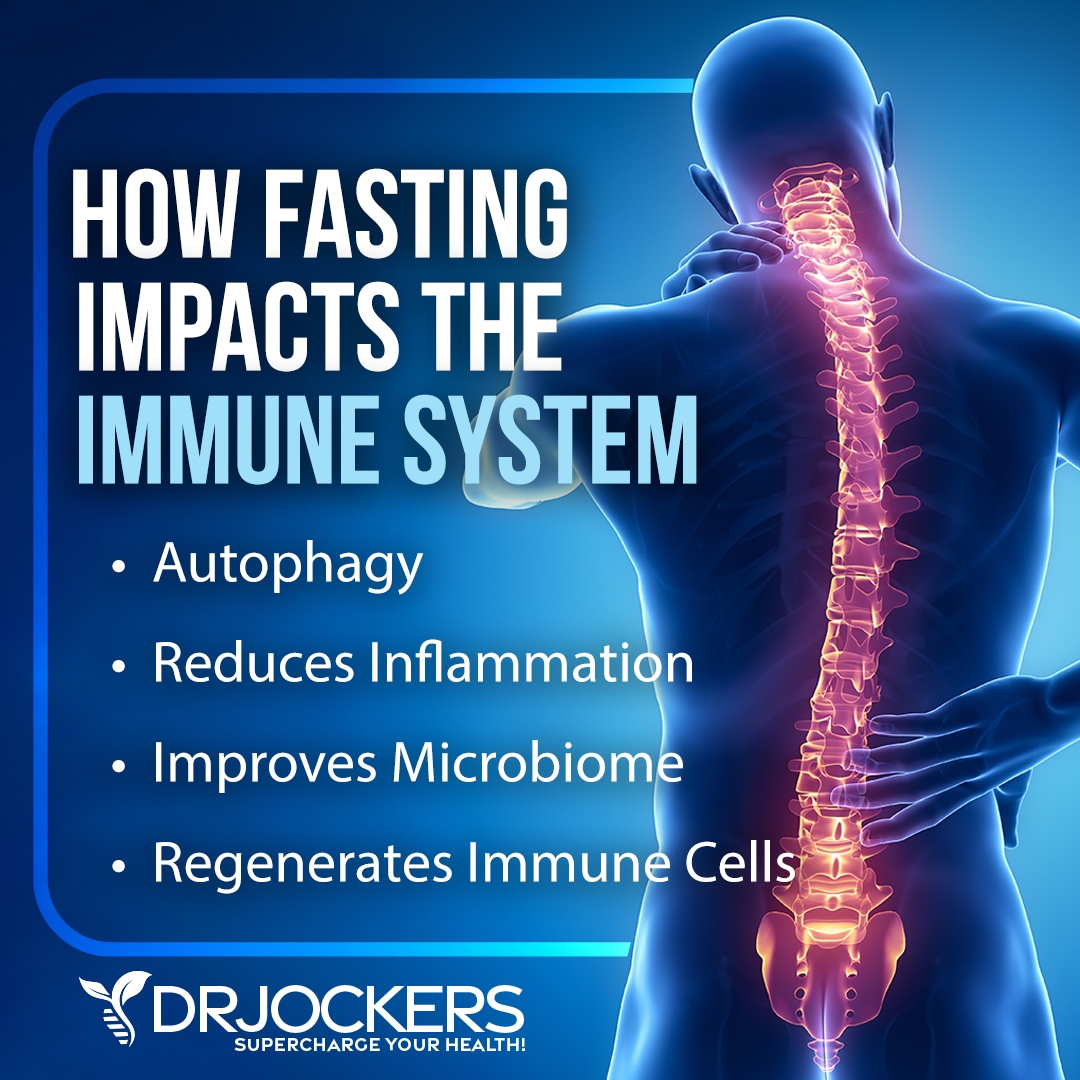
Consider Digestive Enzymes
You may consider taking digestive enzymes to support your digestion and the breakdown of macronutrients. Good digestive enzymes help you absorb more nutrition from the food you are consuming.
I recommend Super Dzyme. This supplement supports the healthy digestion of macronutrients, enhances nutrient absorption, supports the breakdown of polysaccharides, and helps the breakdown of lactose.
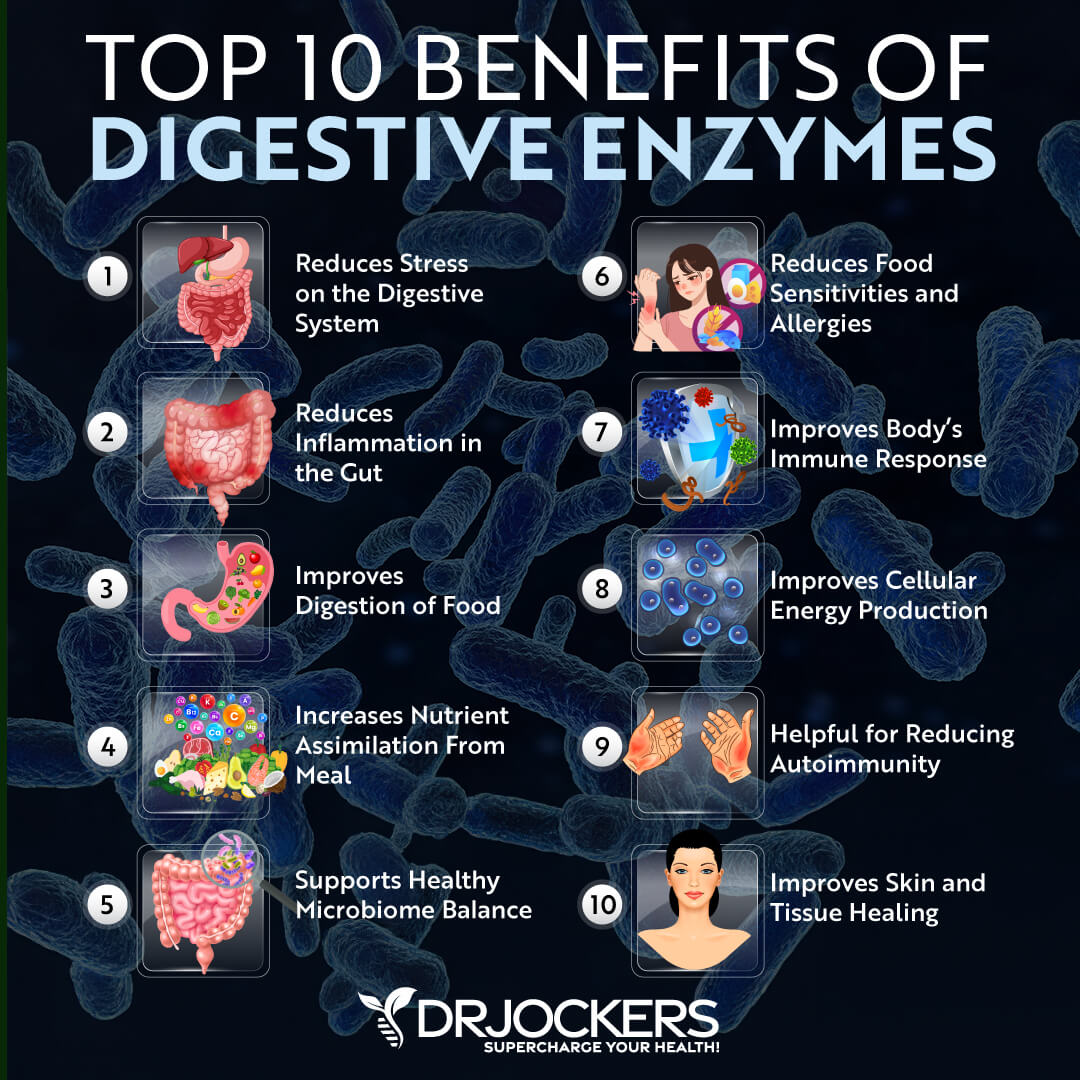
Consider Stomach Acid & Bile Support
You may also consider a stomach acid and bile support supplement. I recommend Super Digest HCL. It contains betaine hydrochloride (HCI) for proper stomach acidity and optimal breakdown of food, lactase to breakdown the milk sugar, lactose, dipeptidyl peptidase IV (DPPIV) for the breakdown of gluten and casein, and ox bile extract and lipase to emulsify and digest fats and fat-soluble vitamins.
This product is fantastic for supporting the digestive system and helping improve the digestion of fats and proteins by providing stomach acid, bile, and pancreatic enzymes. I use this with individuals who have low stomach acid levels and poor bile flow.
 Consider Taking a Good Quality Multi-Vitamin
Consider Taking a Good Quality Multi-Vitamin
Finally, you may also consider a high-quality multivitamin supplement to improve your micronutrient levels. I recommend Complete Multi-Vitamin. This supplement is designed with select minerals in chelated form.
Chelation is the bonding of minerals to amino acids, which results in molecules that are more bioavailable and better absorbed and assimilated by the body. The chelated iron in this Complete Multi-Vitamin containing copper will not result in constipation or GI upset as may be experienced from other forms of supplemental iron.
Final Thoughts
Personalized nutrition based on your personal health history, health issues, and goals is critical. General nutrition principles can guide your journey. I recommend that you follow my tips in this article when creating the best nutrition plan to follow for your health and well-being.
If you want further help with your health, we offer long-distance functional health coaching programs. For further support with your health goals, just reach out and our fantastic coaches are here to support your journey.
Inflammation Crushing Ebundle
The Inflammation Crushing Ebundle is designed to help you improve your brain, liver, immune system and discover the healing strategies, foods and recipes to burn fat, reduce inflammation and Thrive in Life!
As a doctor of natural medicine, I have spent the past 20 years studying the best healing strategies and worked with hundreds of coaching clients, helping them overcome chronic health conditions and optimize their overall health.
In our Inflammation Crushing Ebundle, I have put together my very best strategies to reduce inflammation and optimize your healing potential. Take a look at what you will get inside these valuable guides below!
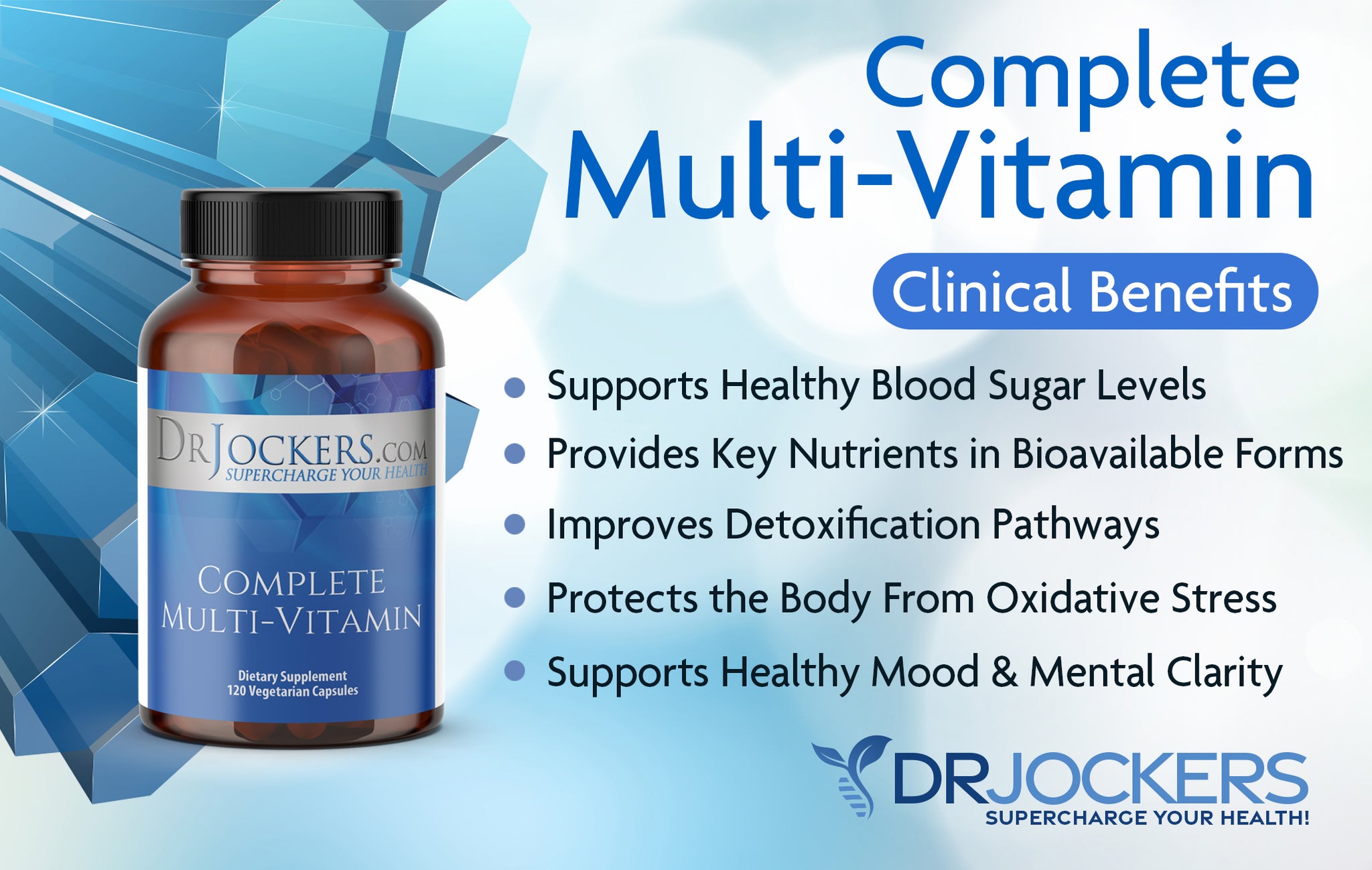




What is the broccoli test mentioned in the “Symptoms of poor pancreatic enzyme production” slide? How do you do the Broccoli test?
I was wondering what place the carnivore diet has in light of these recommendations?
Thank you for always posting useful, concise, and generously illustrated information. I always read and keep your posts for future reference. Thank you for not posting long videos that cannot be sped up to get to the point.
I have watched and read a lot of functional medicine Dr ,dos and don’ts. But I don’t know where to go from here.
I don’t want to purchase supplements and not know if that’s what I need.
Too many choices.I live in Colorado.
Thank you.